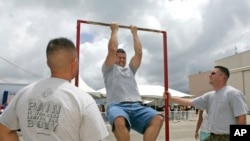As he reveled in the huge display of military might during last week’s Independence Day celebration on the National Mall, U.S. President Donald Trump encouraged Americans to enlist in the military.
“To young Americans across our country, now is your chance to join our military and make a truly great statement in life, and you should do it,” Trump said in his speech at the Lincoln Memorial.
Speaking to reporters outside the White House the following day, Trump predicted that his display would boost military enlistment. “Based on that, we’re going to have a lot of people joining our military,” he said.
However, with a 2016 Department of Defense report finding that nearly three-quarters of young Americans are unfit to serve in America’s military, Trump’s encouragement and military display may not be enough to reverse declining military recruitment.
According to the Department of Defense, the Navy, Marines, and Air Force met their recruiting goals in 2018, but the Army, the military’s largest branch, fell more than 6,500 recruits short – about 8% below its target of 76,500.
A 2018 report by Mission: Readiness, a group of 750 retired military professionals that makes policy recommendations to increase the percentage of young Americans eligible to serve in the military, found that 71% of Americans between the ages of 17 and 24 fail to meet all of the basic requirements for military service.
The biggest disqualifier is obesity, with roughly 31% of American youths disqualified because they are overweight. Other factors explaining the shortage of eligible recruits are inadequate education, criminal history and drug use. According to Army Major Gen. (Ret.) Allen Youngman, a member of Mission: Readiness, almost 25% of high school graduates are unable to pass the basic military entrance exams, which not only disqualifies them from technical positions within the service but also from military service as a whole.
Not only is the pool of eligible recruits shrinking, but the number of young Americans interested in military careers is dropping as well, the report found. This is partly the result of a strong national economy, since plentiful civilian jobs may make military careers seem less appealing, according to Youngman.
As the number of people serving in the military declines, the problem is likely to get worse. “The number of what we call influencers in a young person’s life – people who may have had military service of their own who would serve as a role model or even encourage a young person to consider military service – is down because the number of persons who participate in the military over the years has gone down,” said Youngman. The U.S. Army Recruiting Command reports that 79% of recruits have a relative who also served in the military.
Relaxing education or criminal history standards in order to enlarge the recruiting pool in light of the obesity issue isn’t an option, said General Youngman. “The position today is that the standards are the standards. We’ve just got to work harder to find young people who can meet them.”
However, the trends are not encouraging.
By age two, 14% of American children are already considered obese, and the proportion of overweight or obese children increases with age, the Mission: Readiness report finds. In the 16-19 age group, 42% of Americans are overweight. These statistics carry over into adulthood, with 70% of overweight teens becoming overweight or obese adults.
The problem is especially acute in southern states, which provide a disproportionately large percentage of military recruits, but also have some of the highest rates of obesity in the nation.
Efforts are under way to improve the health of America’s youth.
As an example, Youngman cited the Healthy, Hunger-Free Kids Act, which provides improved nutrition guidelines for school lunches. The program is the latest in a series of initiatives beginning with the National School Lunch Program in 1946.
“A lot of people don’t realize that the School Lunch Program started right after World War II as a national security program,” General Youngman said. “There was such concern about the overwhelming numbers of young people who were not qualified for military service in World War II because they grew up during the Great Depression and they had all sorts of nutrition issues that resulted in health issues later on.”
In the wake of the Great Depression, the goal of the School Lunch Program was to ensure that kids got enough calories from their school lunches. Today, calories are in general much easier to come by, so modern school lunch programs focus on helping students make healthier food choices. A 2014 study of 1,030 elementary-school children found that students selected 23% more fruit for their lunches and ate 16% more vegetables after the implementation of the Healthy, Hunger-Free Kids Act.
Programs that seek to improve nutrition for school-aged children as well as encourage active lifestyles are important not only for military readiness, but also for society as a whole.
“There are some bright spots out there, but as a nation we still have a long way to go,” Youngman said.








